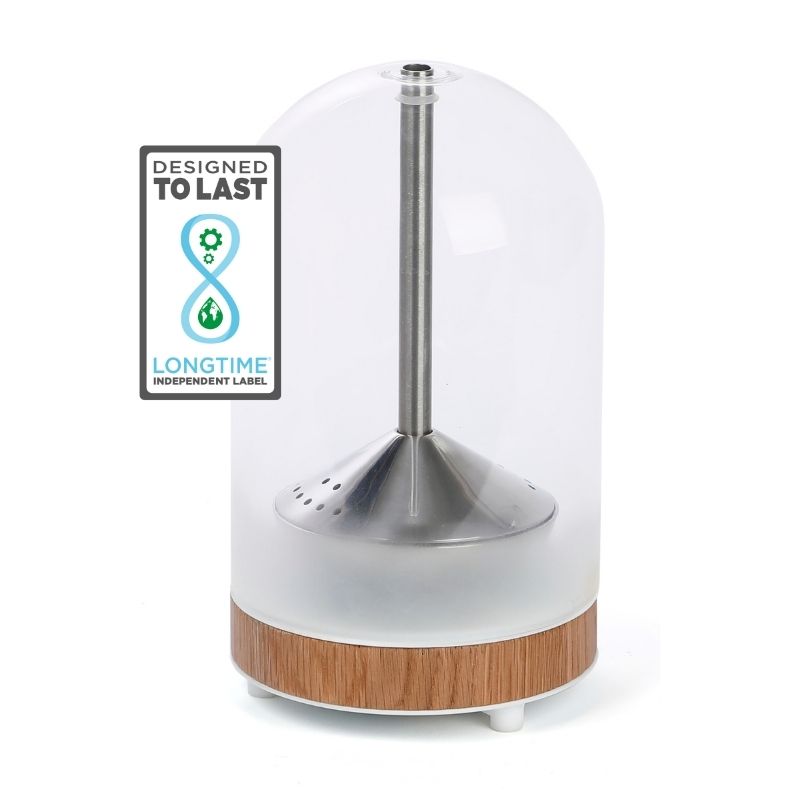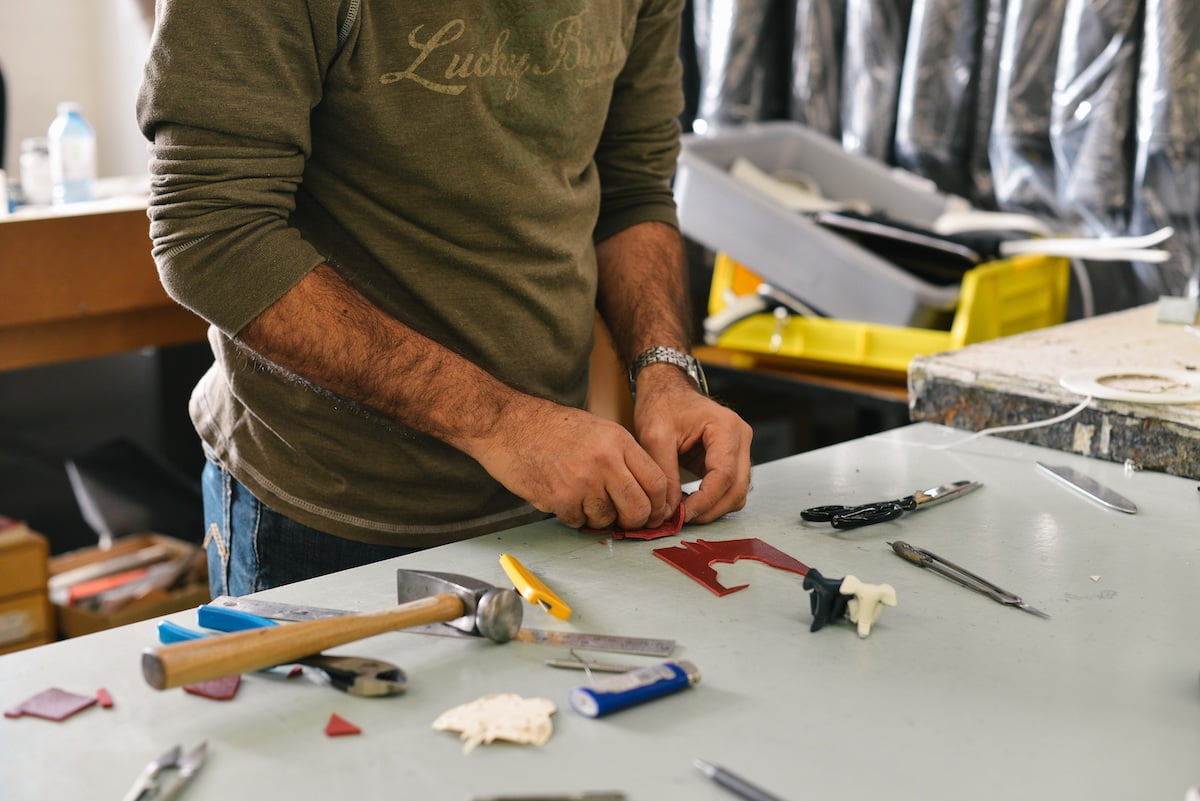How do you choose a durable, repairable diffuser?
Discover reliable, repairable essential oil diffusers with the LONGTIME® label. Would you like to know everything there is to know about choosing the right essential oil diffuser ? Read our buying guide based on feedback from our durability experts.
For aromatherapy, therapeutic use, relaxation for your well-being or home fragrance, essential oil diffusers are products that allow you to take full advantage of the benefits of your favourite oils and their aromatic compounds by diffusing them into the ambient air. It's not easy to choose between essential oil diffusers that use nebulisation, misting, gentle heat or ventilation.
Would you like to enjoy the benefits of essential oils and buy or give as a gift a reliable, long-lasting diffuser? We're here to help.

Because we think that knowledge is power, we get a little technical. If the rest of this article seems a little complex, simply put your trust in the LONGTIME® label. An essential oil diffuser recently received the label after being independently assessed against our 41 sustainability criteria. What's more, they're eco-designed!
How does an essential oil diffuser work?
If you want to enjoy the full benefits of aromatherapy in complete safety, essential oil diffusers are particularly recommended. But what exactly is an essential oil diffuser? Whatever the diffuser technology, the objective remains the same: to extract the organic compounds from the few milliliters of essential oils and diffuse them into the ambient air for inhalation.
On the essential oil diffuser market, four main technologies stand out:
- Soft heat diffusion :
Soft heat essential oil diffusers work in a very simple way. A small heating element heats a surface, usually ceramic, onto which you place a few drops of pure or slightly diluted oils. But simplicity must go hand in hand with reliability. If the heat is poorly regulated, your essential oils will break down at temperatures as low as 40°C, releasing undesirable organic compounds that may even be toxic to your body.
- Ventilation diffusion:
Ventilation essential oil diffusers are also based on a very simple operating principle, but require accessories. A small fan directs a flow of air onto an absorbent material soaked in essential oil. Generally made of cellulose, these blotters, also known as pads or tablets, need to be changed for each oil and renewed after six months to a year. Some fan diffusers have done away with this consumable but retain the same technological principle. Their small size means they can be used on the move.
- Nebulizer diffusion :
Nebulizing essential oil diffusers work with pure essential oils, so there's no need to add water. Their main mechanism of action is the venturi effect. A rapid, well-directed flow of air diffuses aromatic compounds into the ambient air. These diffusers are intended for therapeutic use of essential oils or for diffusion in large volumes. Beware of the fragility of these diffusers. Made from a lot of glass, they won't stand up to knocks or falls;
- Fogging :
Mist diffusers use a slightly less complex but no less effective technology, and work with essential oils diluted in water. Their mechanism of action is based mainly on ultrasonic vibrations. A small pellet, called a ceramic transducer, is placed at the bottom of the diffuser;
The ceramic transducer is made of a piezoelectric material, which means that when an electric current passes through the pellet, it reacts and starts to vibrate at a very high frequency. These vibrations cause the water to resonate and vibrate, releasing a cold mist (not steam) that is responsible for importing the essential oil molecules. Like misters, they have the advantage of adding a little moisture to the air inside your home.
How to check the reliability and robustness of an essential oil diffuser?
You've chosen the technology that best suits your needs; perfect.
But which essential oil diffuser to choose?
To ensure you make a safe and trustworthy purchase, there are certain features and points we recommend you pay attention to; deciphering.
How do you check the reliability and repairability of a fan-assisted essential oil diffuser?
These devices are very simple in terms of design. The priority components will be the fan and the electronic board. These two components will only be used to a limited extent during operation of the product. Make sure that the diffuser is from a recognised brand, that the fan makes no (or very little) noise and that the perceived quality seems good (nothing moves, quality casing).
In the event of a breakdown or accident (e.g. a fall), these parts should normally be removable and replaceable, provided that everything is not soldered to the electronic board. Check with the manufacturer for availability and accessibility;
How to check the reliability and reparability of a gentle heat essential oil diffuser?
The design of these devices is equally basic. The main components of essential oil diffusers using gentle heat are the resistor, the electronic power supply board and the material used to receive and heat the oil.
- A quality electrical resistor is generally made of a Nichrome wire, placed in an insulating tube filled with magnesium oxide powder to insulate it perfectly from oxygen. A higher quality resistor may also use TFE instead;
- The material used to hold the oil must be able to withstand both the (gentle) heat and the corrosion of essential oils. Ceramic is one of the most popular materials used by manufacturers;
- The electronic power supply board will be subjected to little stress, but it must be equipped with regulation capabilities to maintain a surface temperature below 40 degrees.
Be careful, gentle heat diffusers are sensitive to dropping. Resistors don't like shocks and ceramic can be brittle.
How to check the reliability and reparability of a nebulizer essential oil diffuser?
Nebuliser diffusers are the most complex technology available. They are used with pure oils and are ideal for use in aromatherapy. They work on the basis of fluid dynamics, particularly the venturi effect and Bernoulli's principle.
A small air pump is coupled to two glass micro-tubes that generate a light mist of essential oil.
- The air pump must be high-quality and silent to combine comfort, durability and performance.
- Glassware, especially micro-nozzles, must be well made to ensure good diffusion.
How do you check the reliability and repairability of an essential oil mist diffuser or ultrasonic diffuser?
Fogging or ultrasound diffusers (it's the same thing) use technology that is a little more complex than gentle heat or ventilation diffusers, but a lot less complex than fogging diffusers. The main components of ultrasonic diffusers are the ceramic transducer, the fan and the electronic board (power supply, display).
- The ceramic transducer, commonly known as the ultrasonic pad, must be of high quality to ensure that your diffuser operates for a long time. The various ultrasonic tablet quality markers range from a few hundred hours for the worst to several thousand hours for the best. Whatever the case, this element is subject to wear and tear and should be replaceable to ensure you have a long-lasting diffuser;
- The fan consists of a small electric motor and blades or turbines. The quality of the fan depends on the electric motor, its winding and above all its bearings. Ideally (but this is very rare) silentblocks absorb vibrations for your comfort.
- Moisture protection must be well designed to protect all electronics from falling humidity.
Reliability of the electronic boards in the diffusers :
Almost all diffusers have a set of electronic components mounted on the surface of a board. This is the brain of your diffuser, and in particular it will control temperature regulation, diffusion power, lighting options, the timer and safety.
As usual, the quality of the electronics is crucial to the life of your diffuser. The quality of the components, the quality of the design and the architecture of the board are crucial points, particularly for diffusers exposed to humidity.
Be absolutely sure to check the company's policy on electronics: how long the boards are available, the possibility of component repairs, reconditioned electronic boards, protection of the board against overcurrents, etc. Don't be afraid to ask questions! Just because diffusers are small household appliances doesn't mean they shouldn't be durable and repairable;
Reliability of diffuser connectors:
On diffusers, as on many small electrical appliances, the power port is a real Achilles' heel. As far as possible, check the solidity of this charging port and bear in mind that micro-usb charging ports are more sensitive than many other ports.
Diffuser options :
Essential oil diffusers that use nebulisation or misting are able to offer a wide range of options: timer, light ambiance, Bluetooth audio connection, LED light, etc. Be careful, these options are likely to cause more malfunctions. If you're on a tight budget, focus your search on basic but high-quality diffusers.
For all these parts, the choice of quality materials and the company's design and integration expertise will have a major influence on the lifespan of your diffuser and its ease of use. So beware of low-cost diffusers, which are likely to be disposable products that will give you absolutely no satisfaction;
Which broadcast technology is right for your needs?
Fogging, nebulizing, gentle heat or ventilation diffusers: What are the differences between them and how do you choose the right one?
A number of factors can influence your choice. To determine which diffuser is right for you, it's a good idea to look at a number of factors, and take stock of your needs and constraints.
Diffusion for aromatherapy or home fragrance:
- Primarily therapeutic use With this in mind, we recommend that you use diffusers by nebulization or misting (up to 30m2).
- Use as a home fragrance: All diffusers allow you to perform this function, but it may not be necessary to invest in complex technology such as nebulization.
- Mixed use: Diffusers that can be used for both therapeutic and home fragrance purposes are mist and nebulizer diffusers.
Choose a diffusion technology suited to the volume of the room:
- Space less than 20m2 : If you want to diffuse your oils in small rooms, less than 20 square meters, don't worry, all diffusion technologies are suitable.
- Spaces from 20 to 50m2 : If you want to diffuse in spaces from 20 to 50 m2, mist and nebulizer diffusers are ideal.
- Spaces from 50 to 100m2 : If you want to diffuse in really large volumes, only nebulized diffusers will give you satisfaction.
Choosing a silent essential oil diffuser:
- For bedrooms or small spaces: If you want to diffuse without noise pollution, soft-heat diffusers, fan-assisted diffusers and mist diffusers are recommended.
- For larger spaces: Only mist diffusers will enable you to combine power and silence.
How much to invest in an essential oil diffuser:
There are essential oil diffusers at all price points on the market, and the worst is alongside the best, but overall remember that it's hard to get everything for nothing.
The price of the diffusers will be impacted by the diffusion technology, the quality of the parts that make up the product (quality of the ultrasound pad, the electronic board, the resistor, etc.) as well as the design of the product and the nobility of its materials.
The table below gives you an idea of the prices involved:
| Ventilation | Gentle heat | Fogging | Nebulization | |
| Noise | Low | None | Low | Important |
| Aromatherapy | Yes up to 10m2 | Yes up to 10 m2 | Yes up to 25 m2 | Yes up to 50 m2 |
| Home fragrance | Yes (confined space) | Yes (Small Space) | Yes up to 50 m2 | Yes up to 100m2 |
| Covered area | Very small space | Petit Espace | Large space | Large space |
| Price | Between €20 and €40 | Between €20 and €40 | Between €50 and €150 | Between €50 and €200 |
How to make your essential oil diffuser last as long as possible?
There are two key factors in extending the life of your diffuser: use (choice of oils) and maintenance (cleaning).
Bear in mind that essential oils are particularly fouling products. Even with the most robust and reliable diffuser in the world, if you don't carry out any maintenance work, service life will be considerably reduced.
Our watchword is "Read the use and care instructions" for your essential oil diffuser.
Essential oil diffusers require simple but frequent periodic attention.
Maintenance of essential oil mist diffusers
This diffusion technology is relatively easy to maintain:
- Remember to empty the water from your diffuser's reservoir when you're finished using it. This will prevent the formation of limescale.
- Rinse the tank regularly with clean water and, if necessary, a slight dilution of vinegar to remove oil deposits.
- Regularly check the ultrasonic pad for dirt and, if necessary, clean it with descaler (white vinegar) and a microfiber or cotton swab. Some oils have a high clogging power, so be careful.
Maintenance of nebulized essential oil diffusers
This is the most maintenance-sensitive diffusion technology. The design of the diffuser and the use of pure oils are the main reasons for this:
- After each use and oil change, drain your diffuser and clean it with a product indicated by the manufacturer.
- Beware of the fragility of the verrines and the central pipette, which is particularly fragile.
- In the event of prolonged immobilization, follow the cleaning instructions carefully, as there is a risk of clogging your diffuser due to solidification of the oils.
Maintenance of essential oil diffusers using ventilation and gentle heat:
These diffusers are the easiest to maintain: a simple wipe with a cloth is all it takes to remove essential oil residues.

How to repair your essential oil diffuser?
The best breakdown is the one that doesn't happen. You have invested in a beautiful diffuser or received one as a gift. To avoid breakdowns and problems, here is a short list of basic rules to follow:
- Choosing the right broadcast technology for your needs
- Avoid entry-level products
- Check availability of spare parts (electronics, ultrasound pad, tank, fan)
- Comply with usage and, above all, maintenance instructions
- Use oils adapted to the appliance (preferably organic)
- Respect the quantity of water or oil to be poured into the diffuser
If you observe these few basic rules and have chosen a durable, i.e. robust, reliable and repairable diffuser, you should be relatively safe.
However, no brand is immune to failure, and no product is infallible.
You turn on your diffuser and nothing works: Why has my diffuser stopped working? Why doesn't my diffuser heat up? Why won't my diffuser light up? Why doesn't my diffuser make a mist? Why is my diffuser making noise? If any of these questions sound familiar, we'll try to help.
Please note that on these small electrical devices, particularly on fan-assisted and soft-heat diffusers, access to internal components may be restricted, especially on entry-level models.
For fogging and misting diffusers, you should normally be able to access the internal components without difficulty, and there's no reason why accessibility to the main components (ultrasound pad, circuit board, fan, pump) should be impeded.
In the event of a breakdown, check the warranties first:
- If your essential oil diffuser is less than two years old, contact the distributor who sold it to you. He is legally responsible for the legal guarantee of conformity.
- If your diffuser is more than two years old, check whether you have taken out additional insurance or extended warranty cover. Also check manufacturers' warranties or commercial warranties, which may be extended to take over from the legal warranty of conformity;
Your appliance is no longer under warranty, don't panic! There are several points to check before declaring your product out of service:
- In all cases, first contact the after-sales service of the brand of your product, either directly with the manufacturer or through the installing dealer.
- Before carrying out any repairs, always check that the diffuser is correctly powered by checking your plug. To do this, unplug your diffuser from its socket and plug in another appliance (bedside lamp, clock radio, telephone charger) or test it on another socket. If nothing happens, there's a good chance that the problem is with your electrical network.
- If your diffuser operates on a USB port, check that the problem is not with your cable.
- Also check that the connection to the charging port is correct and that there is no false contact.
- Your product is powered up correctly, but is not working properly. Clean your unit thoroughly, following the manufacturer's recommendations.
- Your misting diffuser no longer produces a mist. It's possible that your ultrasound pad is faulty, scaled or clogged. This can easily be replaced if the manufacturer offers the part or if you find an equivalent reference on the internet.
- Your gentle heat diffuser has stopped heating. If it is correctly powered, it is likely that the internal resistor has failed.
Essential oil diffuser repair and DIY* tutorial
For the more do-it-yourselfers among you, some problems can be solved by DIY (self-repair). The Internet is full of explanatory videos, and there are many groups on forums.
You'll learn how to properly maintain and use your diffuser, or how to check and change your ultrasound tablet. However, as with all electrical or electronic products, make sure you have a solid grounding so you can work safely and avoid damaging the safety of the appliance and your home.
And don't forget the help you can get from Repair Cafés for small breakdowns.
When it comes to durability, it's essential to make sure that the manufacturer of your diffuser has a high-quality after-sales service and/or technical support. All LONGTIME®-labeled products are repairable, so don't throw them away.
To sum up, to choose an essential oil diffuser :

- Take stock of your needs to choose the right broadcast technology
- Choose brands with genuine technical support
- Check the availability and price of spare parts
- Make sure all priority parts are accessible: electronic board, fan, ultrasonic pad, pump...
- Try to handle the product to hear its sound and feel the quality of its materials and assemblies.
Would you like to buy an essential oil diffuser without being an aromatherapist or reading 10 rigged comparisons?
Take a look at our product directory and you're sure to find what you're looking for!
Please note: essential oil diffusers are not just decorative accessories and must be used in complete safety. Some oils may be toxic for children and pregnant women...
Ask your pharmacist or an expert for advice.

